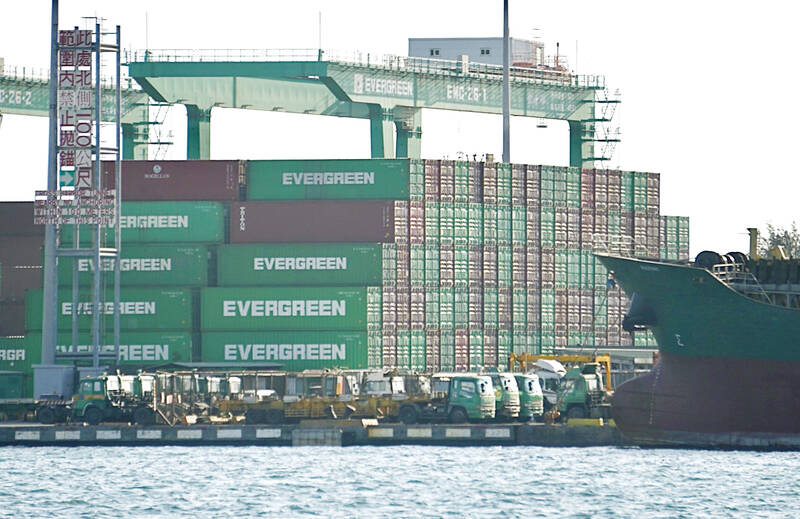Taiwan’s exports last month fell 21.2 percent from a year earlier to US$31.51 billion, as demand weakened across all product categories, aggravated by the Lunar New Year holiday, the Ministry of Finance said yesterday.
Exports would again decline this month by a double-digit percentage due to a poor global economic outlook and it being the slow season for technology products, Department of Statistics Director-General Beatrice Tsai (蔡美娜) said.
“It is noteworthy that the soft patch experienced by consumer electronics extended to chip sales, which shrank 18.3 percent in January” after holding firm last quarter, Tsai said.

Photo: CNA
Contract chipmaker United Microelectronics Corp (聯電) on Monday reported a 4.31 percent annual decline in revenue last month, with capacity running at 70 percent amid inventory corrections, Tsai said.
Advanced peer Taiwan Semiconductor Manufacturing Co (台積電) is to release its sales figures on Friday after recently saying that it expects a 14 percent sequential drop in revenue for this quarter.
Poor visibility makes projections difficult, but exports are most likely to remain in contraction mode through the first half of this year based on the Directorate-General of Budget, Accounting and Statistics’ forecast in November last year, Tsai said, adding that the agency would update its estimate later this month.
Shipments to China, Taiwan’s largest export destination, declined 33.5 percent year-on-year last month — the worst pace in 14 years, Tsai said, adding that revenge consumption, which had been expected after China ditched its “zero COVID” policy in December, was not yet visible.
China accounted for 62 percent of last month’s exports, she said.
Exports to ASEAN markets slumped 26.7 percent, while those to the US decreased 14.5 percent, more than offsetting increases of 3.1 percent and 2.5 percent to Japan and Europe, Tsai said.
“It is too early to speculate about a turnaround for any location, as shipment ups and downs are common during the process of bottom building,” she said.
Demand for plastic products and optical devices were particularly weak due to tepid end-market demand and annual maintenance, she said.
Without the Lunar New Year holiday, the decline in exports could have shrunk to 9.4 percent, Tsai said.
Imports also took a hit, falling 16.6 percent year-on-year to US$29.17 billion, giving Taiwan a trade surplus of US$2.34 billion, which was 53.3 percent lower than a year earlier, the ministry said.
Economic uncertainty dampened corporate interest in purchasing industrial and agricultural materials used for exports, Tsai said.
Firms also refrained from buying capital equipment to upgrade technology or expand capacity, she added.

The US dollar was trading at NT$29.7 at 10am today on the Taipei Foreign Exchange, as the New Taiwan dollar gained NT$1.364 from the previous close last week. The NT dollar continued to rise today, after surging 3.07 percent on Friday. After opening at NT$30.91, the NT dollar gained more than NT$1 in just 15 minutes, briefly passing the NT$30 mark. Before the US Department of the Treasury's semi-annual currency report came out, expectations that the NT dollar would keep rising were already building. The NT dollar on Friday closed at NT$31.064, up by NT$0.953 — a 3.07 percent single-day gain. Today,

‘SHORT TERM’: The local currency would likely remain strong in the near term, driven by anticipated US trade pressure, capital inflows and expectations of a US Fed rate cut The US dollar is expected to fall below NT$30 in the near term, as traders anticipate increased pressure from Washington for Taiwan to allow the New Taiwan dollar to appreciate, Cathay United Bank (國泰世華銀行) chief economist Lin Chi-chao (林啟超) said. Following a sharp drop in the greenback against the NT dollar on Friday, Lin told the Central News Agency that the local currency is likely to remain strong in the short term, driven in part by market psychology surrounding anticipated US policy pressure. On Friday, the US dollar fell NT$0.953, or 3.07 percent, closing at NT$31.064 — its lowest level since Jan.

Hong Kong authorities ramped up sales of the local dollar as the greenback’s slide threatened the foreign-exchange peg. The Hong Kong Monetary Authority (HKMA) sold a record HK$60.5 billion (US$7.8 billion) of the city’s currency, according to an alert sent on its Bloomberg page yesterday in Asia, after it tested the upper end of its trading band. That added to the HK$56.1 billion of sales versus the greenback since Friday. The rapid intervention signals efforts from the city’s authorities to limit the local currency’s moves within its HK$7.75 to HK$7.85 per US dollar trading band. Heavy sales of the local dollar by

The Financial Supervisory Commission (FSC) yesterday met with some of the nation’s largest insurance companies as a skyrocketing New Taiwan dollar piles pressure on their hundreds of billions of dollars in US bond investments. The commission has asked some life insurance firms, among the biggest Asian holders of US debt, to discuss how the rapidly strengthening NT dollar has impacted their operations, people familiar with the matter said. The meeting took place as the NT dollar jumped as much as 5 percent yesterday, its biggest intraday gain in more than three decades. The local currency surged as exporters rushed to